Related Research Articles

The Aerobee rocket was one of the United States' most produced and productive sounding rockets. Developed by the Aerojet Corporation,the Aerobee was designed to combine the altitude and launching capability of the V-2 with the cost effectiveness and mass production of the WAC Corporal. More than 1000 Aerobees were launched between 1947 and 1985,returning vast amounts of astronomical,physical,aeronomical,and biomedical data.

The Aerojet General X-8 was an unguided,spin-stabilized sounding rocket designed to launch a 150 lb (68 kg) payload to 200,000 feet (61.0 km). The X-8 was a version of the prolific Aerobee rocket family.
Aerojet was an American rocket and missile propulsion manufacturer based primarily in Rancho Cordova,California,with divisions in Redmond,Washington,Orange and Gainesville in Virginia,and Camden,Arkansas. Aerojet was owned by GenCorp. In 2013,Aerojet was merged by GenCorp with the former Pratt &Whitney Rocketdyne to form Aerojet Rocketdyne.

The Scout family of rockets were American launch vehicles designed to place small satellites into orbit around the Earth. The Scout multistage rocket was the first orbital launch vehicle to be entirely composed of solid fuel stages. It was also the only vehicle of that type until the successful launch of the Japanese Lambda 4S in 1970.
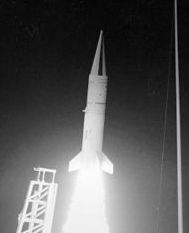
Aries is an American sounding rocket and target rocket,developed by Space Vector Corporation from retired LGM-30 Minuteman I intercontinental ballistic missile (ICBM) stages for use by the United States Air Force and NASA. Taken over by Orbital Sciences Corporation,Aries,as the Target Test Vehicle,remains in use.
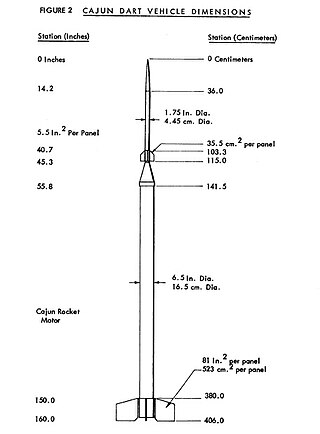
Cajun Dart is the designation of an American sounding rocket. The Cajun Dart was used 87 times between 1964 and 1970. The Cajun rocket motor was developed from Deacon.
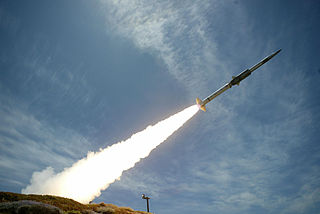
The GQM-163 Coyote is a supersonic sea-skimming missile target built by Northrop Grumman and used by the United States Navy as a successor to the MQM-8 Vandal. Orbital's proposal was chosen over the MA-31,a joint venture between Boeing and Zvezda-Strela. Orbital was awarded the development contract for the Coyote SSST in June 2000.

The LBD-1 Gargoyle was an American air-to-surface missile developed during World War II by McDonnell Aircraft for the United States Navy. One of the precursors of modern anti-ship missiles,it was extensively used as a test vehicle during the late 1940s.
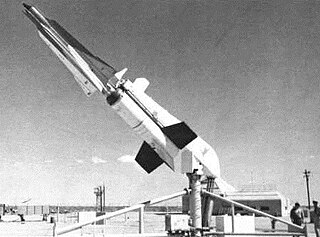
Typhon was a missile system developed by the United States Navy in the late 1950s,intended to serve as an integrated air-defense system for Navy fleets. Consisting of the SAM-N-8 Typhon LR,later designated RIM-50A,and the SAM-N-9 Typhon MR,later RIM-55A,paired with the AN/SPG-59 radar system,the cost of the Typhon system led to it being cancelled in favor of the Standard Missile program.

The NOTS-EV-2 Caleb,also known as NOTS-500,Hi-Hoe and SIP was an expendable launch system,which was later used as a sounding rocket and prototype anti-satellite weapon. It was developed by the United States Navy's Naval Ordnance Test Station (NOTS) as a follow-up to the NOTS-EV-1 Pilot,which had been abandoned following ten launches officially classified as failed missions. Two were launched in July and October 1960,before the cancellation of the project. Following cancellation,two leftover Calebs were used in the Satellite Interceptor Program (SIP),while three more were used as sounding rockets,under the designation Hi-Hoe. These derivatives flew until July 1962,when the Hi-Hoe made its final flight.
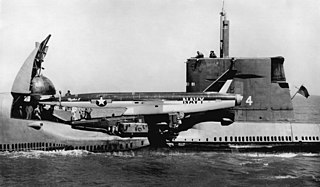
The SSM-N-9 Regulus II cruise missile is a supersonic guided missile armed with a nuclear warhead,intended for launching from surface ships and submarines of the U.S. Navy (USN).
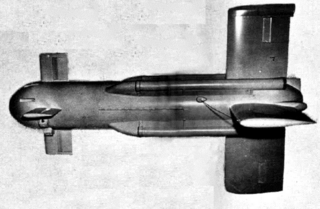
The Little Joe,also known by the United States Navy designation KAN,was an early American ship-based,short-range surface-to-air missile,the development of which was initiated in 1945 as a response to the Kamikaze tactics used by the Japanese. Although the missile was successfully tested,the end of World War II removed the requirement for the missile,and the project was abandoned in 1946.

The AQM-127 Supersonic Low-Altitude Target (SLAT) was a target drone developed during the 1980s by Martin Marietta for use by the United States Navy. Derived from Martin Marietta's work on the cancelled ASALM missile,SLAT proved to have severe difficulties in flight testing,and the project was cancelled during 1991.

The Creative Research On Weapons or Crow program was an experimental missile project developed by the United States Navy's Naval Air Missile Test Center during the late 1950s. Intended to evaluate the solid-fueled integral rocket/ramjet (SFIRR) method of propulsion as well as solid-fueled ramjet engines,flight tests were conducted during the early 1960s with mixed success.
The Cajun was an American sounding rocket developed during the 1950s. It was extensively used for scientific experiments by NASA and the United States military between 1956 and 1976.

The Radioplane XKD4R,known by the company designation RP-70,was an American target drone developed by the Radioplane Division of the Northrop Corporation. Although it was not produced in quantity,it was developed into the successful AQM-38.

The Aerojet SD-2 Overseer was an unmanned aerial vehicle developed by Aerojet General and Rheem Manufacturing Co. in the late 1950s for use by the United States Army. Built in limited numbers,it never saw operational service.

The CTV-N-2 Gorgon IIC –also designated KGN,KUN,and CTV-2 –was an experimental drone,originally intended as a surface-to-surface missile,developed by the United States Navy near the end of World War II. It was used to test control and homing systems for guided missiles,and was also produced in small numbers as a target drone under the designations TD3N and KD2N.
The Naval Research Laboratory Flyrt,or Flying Radar Target,was a small electric-powered unmanned aerial vehicle developed by the United States Naval Research Laboratory to serve as an expendable radar decoy for the defense of United States Navy ships. Tested in the fall of 1993,it was considered successful but was not ordered into production.

The AAM-N-10 Eagle was a long-range air-to-air missile developed by the Bendix Corporation for use by the United States Navy. Intended for carriage by the Douglas F6D Missileer fleet defense fighter,the Eagle program was cancelled before testing could begin,but the lessons learned were used in the development of the AIM-54 Phoenix missile.
References
Citations
- 1 2 Bollermann 1970, p.337.
- ↑ "Sounding rocket from UTC Archived 2014-05-12 at the Wayback Machine ". Flight International, 15 January 1970, p.101. Accessed 2014-05-11.
- 1 2 3 Parsch 2003
Bibliography
- Bollermann, Bruce (1970). A Study of 30 Km to 200 Km Meteorological Rocket Sounding Systems: Literature and data review. Vol. 1, Part 2. Huntsville, AL: NASA: George C. Marshall Space Flight Center. Archived from the original on 2024-04-24. Retrieved 2024-04-24– via NTRS.
- Parsch, Andreas (2003). "Aerojet/UTC PWN-9 Kangaroo". Directory of U.S. Military Rockets and Missiles. designation-systems.net. Archived from the original on 2014-04-19. Retrieved 2014-05-11.